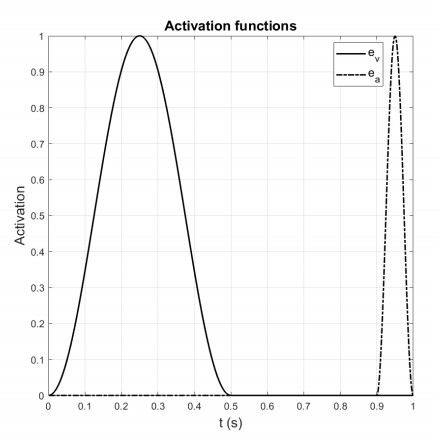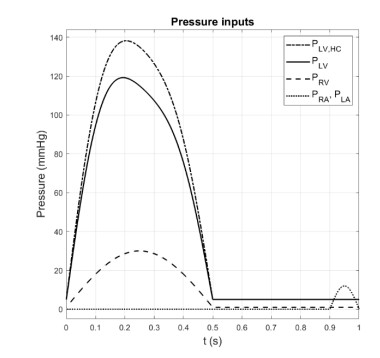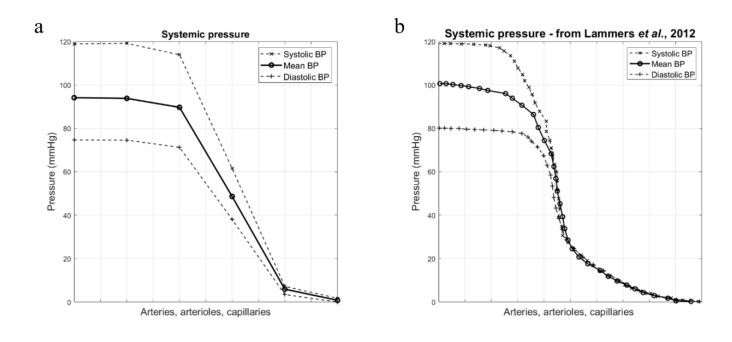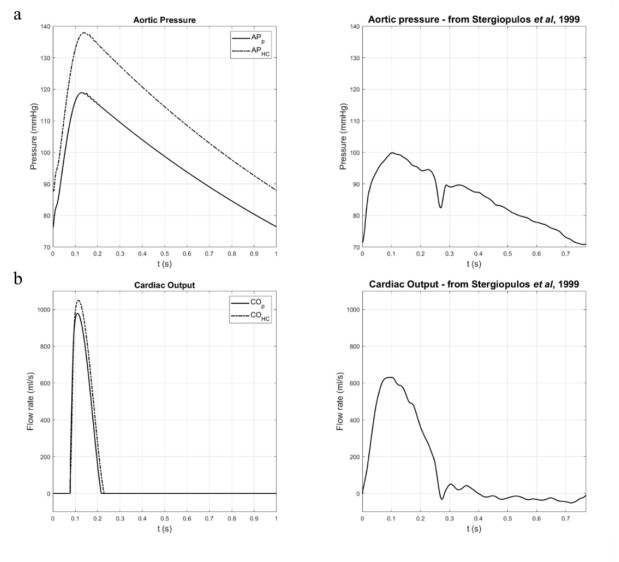Abbreviations: EMF: Electric melting furnaces; LWR: Light water reactor; MRD: Melt receiving devices; SFR: Sodium-cooled fast reactor
1.
Introduction
Currently, in scientific and technical applications, information-analytical systems (IAS) are of particular value, as they allow you to effectively manage large flows of various information, provide deep analytical processing of the results of previously performed studies and make it possible to plan new experiments [1,2,3]. The creation of such IAS is especially important when carrying out work to justify the safety of using nuclear energy.
According to [4] "the cause of a severe accident is a deterioration of the design cooling mode of the core resulting from combination of initiating events, which include failures of nuclear power plant (NPP) equipment elements and external influences". In severe accidents at reactors, uranium dioxide fuel is melted and mixed with structural elements and coolant. Solidified molten fuel with structural materials–corium–can have complex phase composition, which depends on many factors such as the type and mass of structural materials it interacted with, the time of interaction and cooling, etc.
To date, a large amount of experimental work has been carried out in the world in the field of studying severe accidents at nuclear reactors, such as the PHEBUS (France), CORA (Germany), CODEX (Hungary), FARO, KROTOS, RASPLAV (Russia), MACE, WETCOR, SWISS and others [5,6,7,8,9,10,11].
Similar studies are carried out by the National Nuclear Center of the Republic of Kazakhstan on the experimental benches "ANGARA", "EAGLE", "VChG-135" [12]. These experimental benches are used in studying the processes of interaction between the core material melt (corium) and the coolant (water), the material of the melt traps and supporting concrete structures of the reactor (concrete), including candidate materials for the protective coatings of the melt traps and steels-the materials of the power vessels of the reactor.
The technological systems of the benches allow one to vary with a wide range of values from the parameters of the experiments, such as the melt composition, the residual energy release in the melt, the method of cooling models of traps or power housing. The information obtained in the experiments, for the most part, is multivariate, but due to the qualitative generality of the tasks, it has a number of common features that determine the possibility of systematizing and generalizing the results of individual experiments and their series.
The specific experimental layouts and the design of the experimental devices in each specific case depend on the research objectives. In accordance with these goals, the devices are being developed for obtaining simulators of the reactor core melt (crucibles or electric melting furnaces-EMF), melt receiving devices (MRD or traps) and arrangement of the measuring instruments in the experimental devices. These developments are carried out in parallel with the choice and calculation the justification of the modes of conducting experiments, while the melt parameters specified by the technical requirements for the experiments are of decisive importance–component composition, weight and temperature and the magnitude of the simulated residual energy release [13].
The reconstruction of the processes that occurred in the experiments with the simulators of the reactor core melt is carried out within the framework of a joint analysis of the results of direct measurements of the experimental parameters and are based on the material science studies. An array of the material science research results is formed in the dismantling of the experimental devices, visual assessment of the state of all elements of the experimental installations and corium, fragmentation analysis of corium, determination of the elemental and phase composition of its individual fractions, its thermophysical properties, density, porosity and assessment of the degree of erosion of protective materials as a result of their high-temperature interaction with the corium and others.
The long-term studies of the nuclear reactor safety problems at the benches of National Nuclear Center of the Republic of Kazakhstan (NNC RK) made it possible to accumulate a significant amount of information, the valuable use of which in all its diversity is becoming increasingly difficult without the use of modern tools and methods for working with the data arrays implemented in the form of appropriate information bases for their automated processing.
In connection with the above, IAS was created at the NNC RK to solve the problems of processing the results of experiments. In addition to reliable secure storage of the individual parameters of each individual experiment in a single operating space, it provides for standard calculations of the input parameters of experiments, complex analysis and comparison of their individual characteristics and formation of a protocol according to the selected data parameters. Also, the storage of the base of experiments, where the main material for research (the object of research) is the core melt (corium) or its prototype, will not allow experiments to be duplicated, and, accordingly, to minimize work with uranium-containing materials.
The development of the IAS made it possible to solve the following tasks:
- Ensuring the filling of the IAS base with the results of the experiments and systematize them, taking into account their diversity within a single structure. Based on the characteristic features of the simulated processes of a severe accident-for example, experiments can be divided into two groups—experiments simulating the out-vessel and in-vessel stages of a severe accident;
- Defining a set of operator functions for each data block that make up the IAS structure and represent the data in each block in the unified format;
- Developing the analytical modules for the standard calculations, processing of the results and planning of the experiments (thermal power required to obtain corium, power of inductors, coolant parameters of cooling systems, etc.) and comparing the results of various experiments (comparative tabular and diagram representation of the quantitative data, the visual comparison of images and photographic materials, comparison of registration diagrams).
The functionality of the created IAS is to manage the data obtained in the framework of experiments on modeling processes occurring during severe accidents of nuclear reactors. When constructing data comparison algorithms, we consider the aspect that data to be compared is permissible and a number of input conditions are met-dimensions, measurement points, the same scale and a coordinate system. It is impossible to compare and display different data in graphs-the system is built in such a way that only the above data with the same dimension is compared.
It should be noted that IAS is limited by the test data gained in experiments simulating accidents of LWRs and SFRs carried out by NNC and can be open to the scientific community as a result of the special access procedure implementation.
2.
Materials and methods
As mentioned above, the IAS was created, on the one hand, as a tool for a comprehensive analysis of the experimental results performed at the experimental benches. On the other hand, the IAS assures secure storage of the individual parameters of each experiment in a single operating space [14].
Structurally, the IAS data are focused on solving the following major problems (Figure 1):
- Comprehensive characterization of the experimental setups and experimental devices;
- Storage of the recorded parameters of the experiments, as well as of data of the post-experimental studies;
- Quantitative processing of the results of the direct measurements, the qualitative analysis of the results of the post-experimental studies, comparative analysis of the results of the experiments and predictive assessment of the parameters of the planned experiments [15].
To solve these problems, the IAS has three main blocks: "Experimental benches", "Experiments" and "Analysis & Processing".
3.
Results
The block "Experimental benches" contains the design documents for the basic structural elements of the benches, which do not undergo changes during the implementation of individual research and development (R & D).
It includes a description of the plants, information about the period of their operation, design documentation for the major components and systems of the plants. The information in the subsections of the block is stored in textual and graphical form with the possibility of its output in Portable Document Format (PDF).
The "Experiments" block contains the information on the experimental studies for each single project (Figure 2).
The description of each project includes the basic information about the goals and objectives of the research, organizational and methodological documentation (contract text, terms of reference, test programs and methods, etc.), as well as a list of the performed experiments. The description of each experiment usually contains, but is not limited to, the following information:
- Initial data–terms of reference and technical requirements (composition and the ratio of the components of the corium and structural materials, the conditions for their testing, etc.), the program of the experiment, a description of the devices developed for the implementation of the experiment and the instruments used for measuring the parameters and their layouts at the bench and in the experimental setup;
- Arrays of the recorded experiment parameters, such as temperature and pressure in the cavities of the experimental device, temperature, pressure and coolant flow rate for cooling the energy-intensive units of the installation and parameters of the power supply system of the electric melting furnace. These data are generated in the IAS into arrays using SQL software capabilities and, accordingly, can be provided with any necessary descriptions characterizing the features of their registration, including the characteristics of primary converters, registration error, etc. To use experimental data in calculation codes, it is possible to generate tables in numerical format;
- Arrays of the data obtained as a result of post-experimental studies (Figure 3), including the information on the distribution of the melt in the experimental device [16], on the structure, granulometric and elemental-phase composition and thermophysical properties of the fuel and structural materials subjected to high-temperature interaction of the melt.
The results of materials science studies are presented both in the form of photographic materials, spectra, diffractograms and in the form of arrays of numerical values that can be used in calculations, imported into the final protocol of the experiment in the "Analysis & Processing" block [17].
The "Analysis & Processing" block allows you to extract data from the "Experimental benches" and "Experiments" blocks and process them using the analysis tools developed to solve this problem. This is the main block of the developed IAS.
One of the major tasks that the functional tools of the "Analysis & Processing" block are focused on is the selection and justification of corium heating diagrams in the experiments on modeling the processes of the interaction between the core melt and structural materials of a nuclear reactor. When choosing the modes of heating the corium, the greatest difficulty is to process the first experiment in a series due to the lack of the previous experience. In the subsequent experiments of the series, IAS allows making a reasonable choice of the diagram of the operation of the electric melting plant based on the experience of the previous experiments. Figure 4 shows the heating diagram calculated in IAS (Figure 4a) as a prediction of bench tests of VChG-135, and the diagram obtained on bench tests of VChG-135 (Figure 4b), when setting the major parameters, such as power and exposure time in accordance with the calculated forecast [13].
The "Analysis & Processing" block in its basic version contains key relationships for calculating the power of electric heaters, the flow rates of working fluids according to the parameters of restrictive devices and the balance of thermal energy in experimental devices, which are indirect (calculated) parameters in relation to the measurement results. The results of calculations of indirect parameters in each case are provided, taking into account the error, which, is calculated based on the values of the instrumental error of measurement tools and systems. If necessary, users can create and enter the necessary functional calculation equations for them into the workspace allocated for them in the "Analysis & Processing" block.
In the process of analyzing the results of material science research, IAS provides the ability to extract files in in picture format, PDF and visually compare them in 2 or more program windows (Figure 5).
Various types of the complex analysis require the formation of tables: They are used in the elemental and phase analysis, matrices for a series of the experiments and project experiments and the analyses of various compositions of charge, gas, etc. The "Analysis & Processing" block provides the access to the results of both individual experiments and their combination with the ability to select the relevant data in the "Experiments" block by the names of the experiments.
To obtain information on one experiment or to compare the results of several experiments in one document, the "Protocol" function is used, which provides the ability to generate the output forms based on the experimental data contained in the IAS in the form of diagrams, photos, data tables and other information.
When developing the IAS, the following types of software were used:
- SQLServer is used as a relational database that stores all the basic data [18].
- C# and the Blazor framework, where C# is an object-oriented programming language for developing a web-interface developed by Microsoft, which is used to create various types of applications, including web applications, and Blazor is a framework for developing web applications in C# [19].
- Entity Framework, which connects the web interface to the SQLServer database. It is a toolkit that allows developers to work with the data using an object-oriented approach. The Entity Framework automatically generates SQL queries based on the object data model and converts the query results into the objects that can be used in an application code.
4.
Discussion and conclusions
The modeling of a severe accident's processes is a complex task that can be formulated as a problem of non-stationary heat and mass transfer with the chemical reactions in a non-equilibrium system with three aggregate states of matter and changing topology. In this regard, the studies of the processes of corium interaction with the structural materials are of undoubted interest for the specialized organizations and specialists. The IAS, created at the National Nuclear Center of the Republic of Kazakhstan, increases the degree of accessibility of the results of these studies and improves the culture of preparing and conducting such experiments.
Combinations within the IAS of the tools for structuring the research results by clusters and analysis tools causes an increase in processing speed and helps to analyze previously unstructured data from diverse experiments, using a more complete statistical sample. Thus, one can get more reliable results of the compared parameters and decrease errors in the planning of the experiments.
The created IAS makes it possible to simplify work and research to justify the safety of using nuclear energy, as it can significantly reduce the work of contact with the melt of the core of a nuclear reactor (corium) and its prototypes, which is obtained at nuclear benches and installations.
The IAS has much in common with experimental research databases. IAS contains data from experimental databases. However, IAS has more functionality, which include search and comparison algorithms, graphing functions and much more. Therefore, it should be noted that IAS and databases are correlated as general and specific ones. Some specific differences can be found in organizing the user' access verification procedure and the possibility to form their own protocol for results processing.
The main advantage created by the IAS is that its results are based on experiments and studies that have already been carried out. In connection with the above, the use of IAS as a tool for conducting research and predicting the behavior of the melt in the core of a nuclear reactor in order to justify the safety of using nuclear energy is an indispensable component for a researcher.
Use of AI tools declaration
The authors declare they have not used Artificial Intelligence (AI) tools in the creation of this article.
Acknowledgments
This work is carried out within the framework of grant funding from the Ministry of High Education and Science of the Republic of Kazakhstan (IRN AR09260704 "Information and analytical system of data obtained from experimental modeling of severe accident processes at a nuclear reactor", 2021–2023).
Conflict of interest
The authors declare no conflicts of interest.
Glossary
ANGARA: Experimental test bench of NNC, created to carry out tests simulating processes of LWRs corium behavior and interaction with different materials and water coolant.
CORIUM: Composition of the materials simulating a core material melt of a nuclear reactor.
COTELS, FUKUSHIMA DEBRIS, CORMIT, CORMIT-II, IVR, INVECOR: Experimental programs implemented at the ANGARA and VCHG test benches.
EAGLE: Experimental bench of NNC, created to carry out tests simulating processes of SFRs corium behavior and interaction with different materials and sodium coolant.
EAGLE-1, -2, -3: Experimental programs implemented at the EAGLE test bench.
SLAVA, LAVA, LAVA-M, LAVA-B: Experimental devices have been tested at ANGARA test bench.
SQL: Structured Query Language, is a programming language used to talk to databases.
VCHG-135: Small-scale experimental bench of NNC, created to carry out tests to study the properties of LWRs corium and its changes as result of interaction with different materials.
VT, RT, PT: Series of experiments, carried out in frame of the CORMIT-II experimental program.
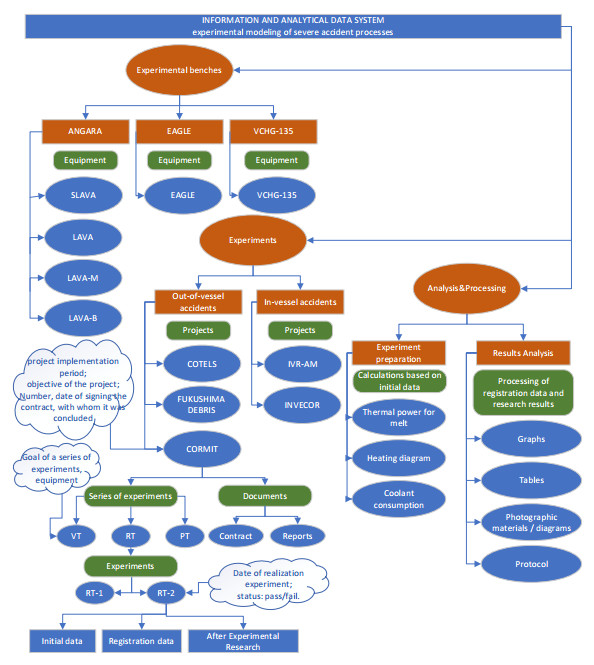









 DownLoad:
DownLoad:







